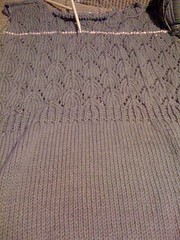This post comes from an idea from Debby – thanks, Debby! Reader additions are in red. Thanks everyone for making this a great resource!
I’m not talking about abbreviations (k2tog, sts, etc). While those are important, we do have them on the site.
I’m talking about all those acronyms (like TAAT) and special words (like laddering). Here’s a (I’m sure partial) list:
CAL: Crochet Along (thanks Alina!)
ER: Every Row/Round (often used when talking about an increase or decrease)
EOR: Every Other Row/Round
Frog: To pull out a portion of stitches (can include multiple rows).
KAL: Knit Along (thanks Alina!)
Ladder: To intentionally drop a stitch (or stitches) down to fix an error. It’s a way to avoid fully ripping multiple rows.
Lifeline (at left): A thin strand of other yarn or thread (often an unscented and uncoated dental floss) that’s threaded through stitches on the needle. It’s used to make it easier to put the work back on the needles if you need to frog. To make it easier to either thread onto a needle or pull out, I suggest using a contrasting color of yarn/thread. ETA – Lee and Michelle have commented that dental floss is too sharp to use as a lifeline. So, you may want to consider a thin crochet thread as Michelle suggested below.
LYS: Local Yarn Store
MCN: Merino/Cashmere/Nylon blend
MAL: Mystery Along
Rip: See frog above. Note this one sounds like “ribbit” and it’s another take on “frog”.
SABLE: Stash Acquisition Beyond Life Expectancy
SIP: Sock-in-progress
TAAT: Two at a time (knitting both of the same thing at the same time, usually socks but could also be other things that are in two as well)
TINK: Unknit (backwards) in order to fix a mistake. Note that TINK is the word KNIT, but backwards. See how clever that is? (thanks Margo!)
WIP: Work-in-progress
W(Y)IB: With (yarn) in back (thanks Karen!)
W(Y)IF: With (yarn) in front (thanks Karen!)
UFO: Unfinished Object
These acronyms can be used when reading articles or posts or patterns. Really, anywhere the written word is used when talking about knitting or crochet. We have our own language and we don’t even realize when we’re using it (I know I’m guilty of that).
I hope this helps when you’re reading on ravelry or when you’re trying to post to get help or assist someone else.
What die I miss, though? I’d like to make this a living list and add to it based on all your awesome ideas. Leave a comment and let me know what I should add!
About the Writer: Jody Richards

I’m the knitting-obsessed, crochet-loving, math-geeky, web-dev girl behind Knotions. I’m passionate about helping crafters become even better at what they love, whether that means understanding why a stitch works a certain way or discovering their next favorite yarn.
Crafting runs deep in my roots—my mom was an avid embroiderer and sewist, and she sparked my lifelong love of all things crafty. Since those early days, I’ve combined my degrees in Math and Computer Science with over two decades of experience in digital marketing to build Knotions into a place that’s both fun and informative.
My mission at Knotions is simple: to empower crafters to craft smarter. Let’s make something awesome together!



How about PABLE – Pattern Acquisition Beyond Life Expectancy
that one works too!
For the lifeline I use a green fishing line. It doesn’t “drag” and is so much easier to pick-up the stitches. I only use interchangeable needles so I thread it through the hole at the base of the needle so its pulled through as I knit. To keep it from sliding out, I tie stitch markers on the ends.
Those are great suggestions! Thanks for sharing 🙂
How about working on my PHD – Project Half Done.
Good one – thanks!
EOR in some instances is used as End Of Row
good point!
each pattern will use it in their own way. this is one of those instances where you’ll have to read the abbreviations.
Another common one online is IMHO – In My Honest Opinion
When I was just starting knitting I couldn’t understand what kind of KALs and CALs people are talking about 🙂
How did I miss KAL/CAL? Thanks for suggesting them! I’m adding it now 🙂
Better add MKAL and MCAL to that list, as well as yfd, and yrn as other British imports that confuse US knitters too.
Good ones! I’ll add them now – thanks!
WIF and WIB – with yarn in back, with yarn in front. A British pattern confused me one time with CO. I don’t know why I immediately thought it was “cast off” which makes no sense now that I’m more experienced.
Good suggestion! I’m also going to add wyib/wyif because I’ve seen it that way too . Thanks!
I’ll object to the suggestion that dental floss be used as a lifeline. One of the reasons that floss works on your teeth is that is is sharp and abrasive. Now using it as a lifeline on cheap acrylic might not do a lot of harm visually, but do you want to subject your laceweight merino/silk to sandpaper in the stitches? A ball of size 10 crochet thread is cheap and effective if you need to use a lifeline and far less harmful to delicate yarns.
You’re the second person now to mention this. I was waiting to get her approval as she sent it via an email – not as a comment on the blog.
Given this I’m going to update the post. Thanks!